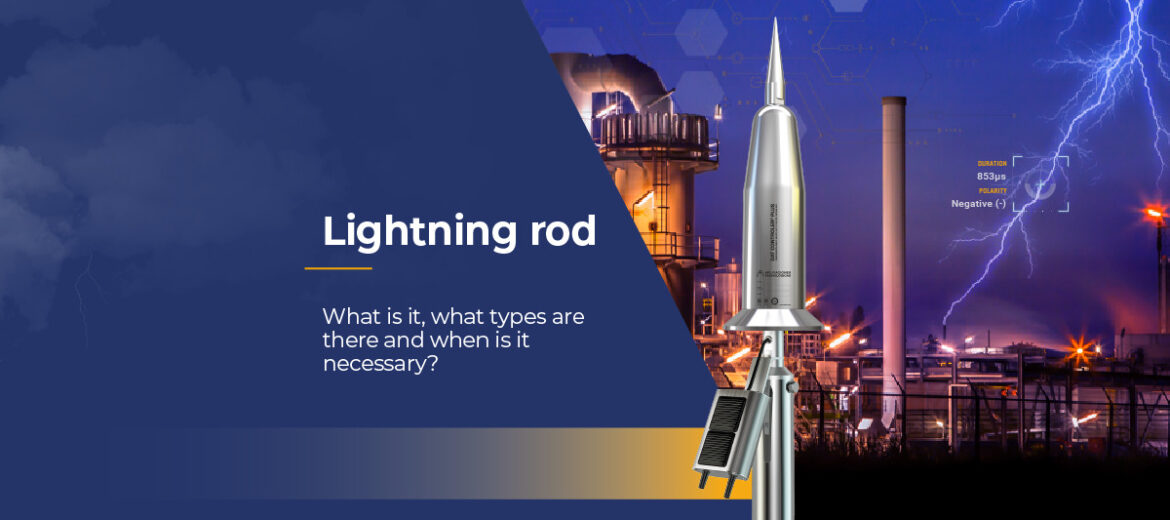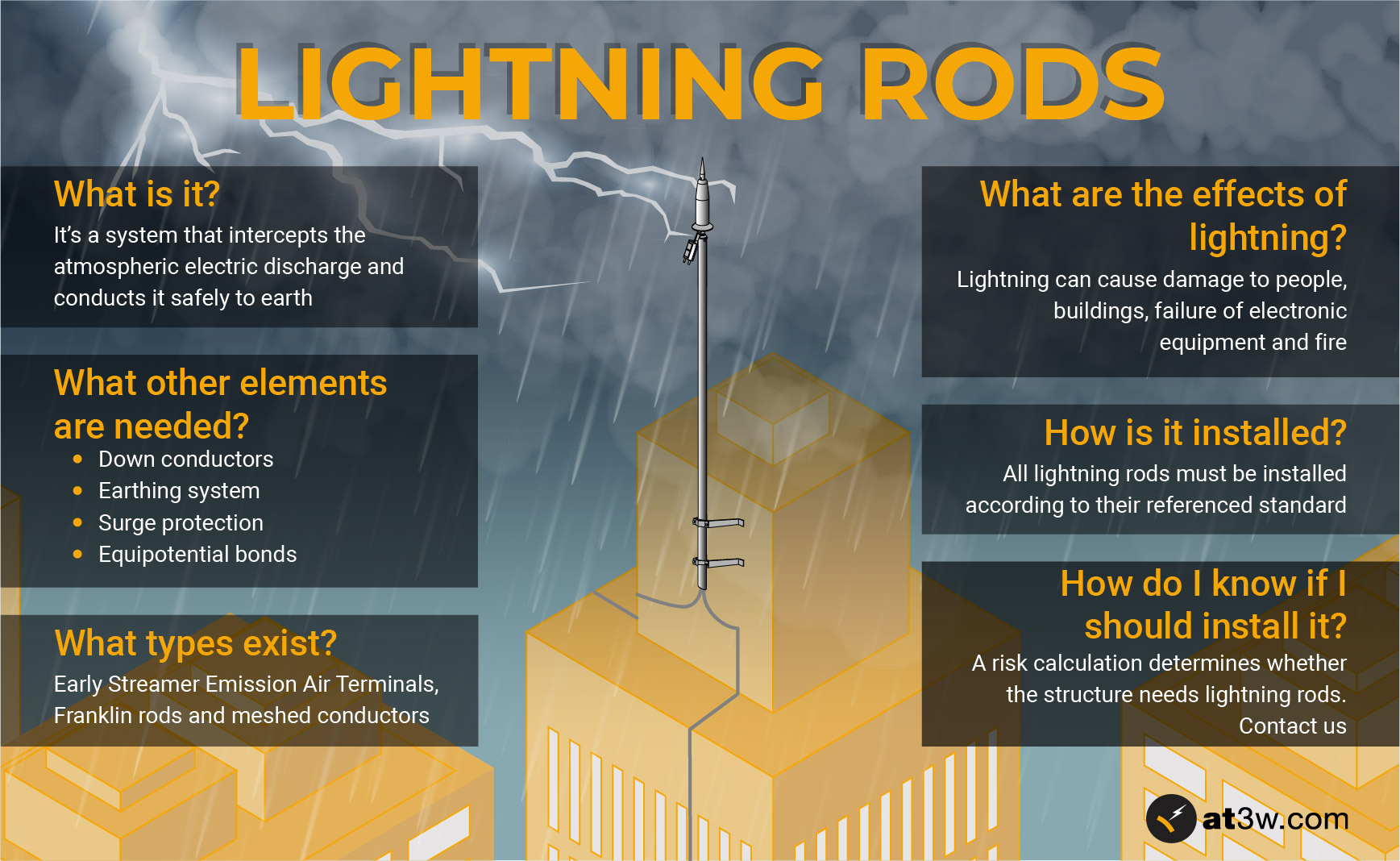Lightning rods, those strangers. We all know what they are for, but do we know how a lightning rod works, are we clear about the advantages of installing a lightning rod, and what elements form part of a lightning protection system? We answer these and other questions here.
What is a lightning rod?
A lightning rod is an interception system that has the aim of intercepting atmospheric electric discharges and conducting them safely to earth. It is installed on any building or structure to prevent lightning from causing harm to people.
Any interception system (lightning rod) should meet the national and international standards or laws that are applied to it (mainly standards UNE 21.186, NFC 17.102, Technical Building Code SU8, Series IEC/EN 62.305 and IEC/EN 62.561).
How is a lightning rod installed?
The lightning rod, in order to fulfil its function, must always be installed above the highest part of the building or structure to be protected so that it captures the electrical discharge from lightning and allows a safe path to earth.
What are the components of a lightning protection system?
The components of a lightning protection system are:
- Interception system (ESE air terminals or Franklin rods and meshes).
- Two or more down-conductors
- An earthing system
- A suitable surge protection installation
- Other measures minimizing the destructive effects of lightning (equipotential bonding, screening etc.)
Why should I install a lightning rod?
The aim of a lightning protection system is:
- Capture the lightning
- Conduct the lightning current safely to earth
- Dissipate the lightning current to the ground
- Provide protection against the secondary effects of lightning
In a world where buildings and equipment are becoming more complex, lightning represents a hazard. One discharge can damage buildings and cause failures in electronic equipment. It can even provoke fire and lead to serious economic losses.
Which are the effects of lightning and why do we use a lightning rod?
- Electrical effects: equipment destruction. Increase in ground voltage and surges can damage the equipment connected to the electrical network.
- Electrodynamic effects: damage to buildings. Deformations and breakages in the structure due to the force generated by the high magnetic field produced.
- Thermal effects: fires. Sparks and heat dissipation by the Joule effect can cause fires.
- Effects on people and animals: electrocutions and burns. A current of a certain intensity passing through the body for a short period of time is enough to cause the risk of electrocution due to cardiac or respiratory arrest. Besides, there is a risk of burns.
- Inductive effects: Within a variable electromagnetic field, induced currents appear in every conductor. If these conductors reach computers or other electronic equipment, irreversible damage may be produced.
What types of lightning rod exist?
Aplicaciones Tecnológicas S.A. is a manufacturer specialised in protection systems against atmospheric electric discharges, putting at your disposal both passive systems and early streamer emission (ESE) air terminals. Here, we explain how each one works:
Early streamer emission air terminals base their operation on the electric characteristics of the lightning formation. Lightning initiates with a downward leader spreading in any direction. Once it approaches the objects placed on the ground any of them can be struck. ESE Lightning air terminals are characterized by emitting a continuous upward leader before any other object within their radius of protection. The lightning rod must be the controlled point of impact of the discharge so that it provides the lightning current with a path to the ground without damaging the structure. The main standards governing this type of lightning protection system are: NFC 17-102, UNE 21186, NP 4426.
The protection radius of an Early Streamer Emission depends on its advance time, the Protection Level of the structure it protects and its height above the point to be protected. The longest advance time that can be applied, according to the regulations, is 60 µs. Lightning rods with this time can protect more than 100 metres, although this always depends on the Protection Level and the height.
For all calculations there are 3 different height sections, both applying the UNE21186 standard and the CTE (Technical Building Code):
- Between the tip and 2 metres below, the lightning rod is not considered to offer protection (arcing may occur, which would cause the discharge to be directed at the supposedly protected object)
- Between 2 and 5 metres, the protection radius varies very sharply (in the order of tens of metres)
- From 5 metres and above, the protection radius hardly changes.
The important thing is to protect the roof of the building (especially the corners) and all the elements on it. For this reason, Aplicaciones Tecnológicas recommends installing the lightning rod on a 6 metre mast, and characterises the protection radius of its lightning rods for this height in each Protection Level.
- Franklin rods and meshed conductors (Passive systems)
Lightning protection using Franklin rods and meshed conductors is used to share and dissipate the lightning current through a network of down-conductors and earth terminations. Sections and materials must meet the requirements of the standards that define this type of system (IEC/EN 62305 series, IEC/EN 62561 series).
How to know if I should install a lightning rod
If you have any doubts about whether or not you should install a lightning rod, in Aplicaciones Tecnológicas we can prepare a customized study based on the standards and your specific needs. You can contact our technicians by clicking here.
If you wish, you can also attend any of our free online lightning protection trainings on our webinars page.

